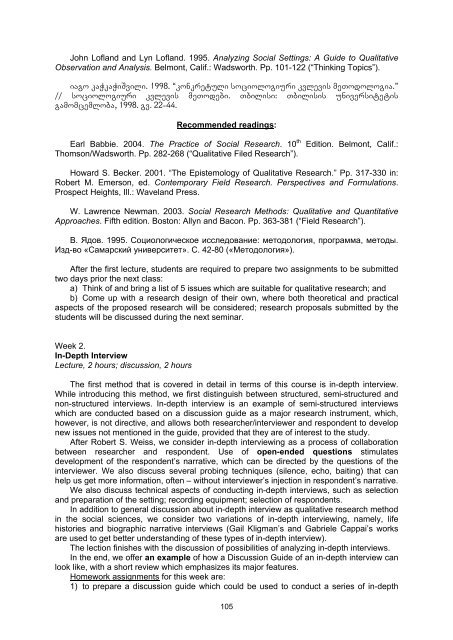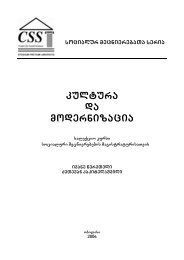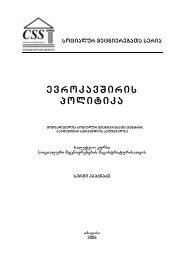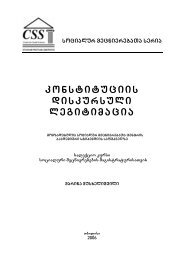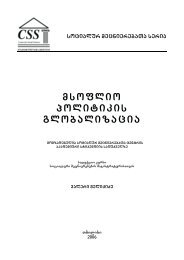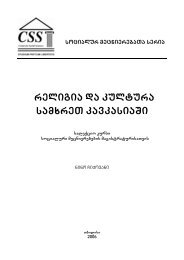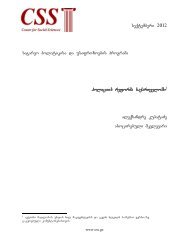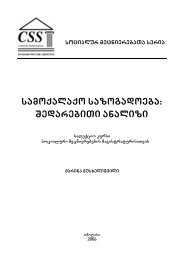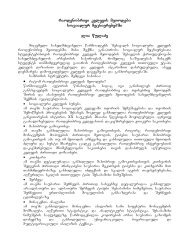Tvisebrivi meTodebi socialur kvlevaSi - Center for Social Sciences
Tvisebrivi meTodebi socialur kvlevaSi - Center for Social Sciences
Tvisebrivi meTodebi socialur kvlevaSi - Center for Social Sciences
Create successful ePaper yourself
Turn your PDF publications into a flip-book with our unique Google optimized e-Paper software.
John Lofland and Lyn Lofland. 1995. Analyzing <strong>Social</strong> Settings: A Guide to Qualitative<br />
Observation and Analysis. Belmont, Calif.: Wadsworth. Pp. 101-122 (“Thinking Topics”).<br />
iago kaWkaWiSvili. 1998. “konkretuli sociologiuri kvlevis meTodologia.”<br />
// sociologiuri kvlevis <strong>meTodebi</strong>. Tbilisi: Tbilisis universitetis<br />
gamomcemloba, 1998. gv. 22-44.<br />
Recommended readings:<br />
Earl Babbie. 2004. The Practice of <strong>Social</strong> Research. 10 th<br />
Thomson/Wadsworth. Pp. 282-268 (“Qualitative Filed Research”).<br />
Edition. Belmont, Calif.:<br />
Howard S. Becker. 2001. “The Epistemology of Qualitative Research.” Pp. 317-330 in:<br />
Robert M. Emerson, ed. Contemporary Field Research. Perspectives and Formulations.<br />
Prospect Heights, Ill.: Waveland Press.<br />
W. Lawrence Newman. 2003. <strong>Social</strong> Research Methods: Qualitative and Quantitative<br />
Approaches. Fifth edition. Boston: Allyn and Bacon. Pp. 363-381 (“Field Research”).<br />
В. Ядов. 1995. Социологическое исследование: методология, программа, методы.<br />
Изд-во «Самарский университет». С. 42-80 («Методология»).<br />
After the first lecture, students are required to prepare two assignments to be submitted<br />
two days prior the next class:<br />
a) Think of and bring a list of 5 issues which are suitable <strong>for</strong> qualitative research; and<br />
b) Come up with a research design of their own, where both theoretical and practical<br />
aspects of the proposed research will be considered; research proposals submitted by the<br />
students will be discussed during the next seminar.<br />
Week 2.<br />
In-Depth Interview<br />
Lecture, 2 hours; discussion, 2 hours<br />
The first method that is covered in detail in terms of this course is in-depth interview.<br />
While introducing this method, we first distinguish between structured, semi-structured and<br />
non-structured interviews. In-depth interview is an example of semi-structured interviews<br />
which are conducted based on a discussion guide as a major research instrument, which,<br />
however, is not directive, and allows both researcher/interviewer and respondent to develop<br />
new issues not mentioned in the guide, provided that they are of interest to the study.<br />
After Robert S. Weiss, we consider in-depth interviewing as a process of collaboration<br />
between researcher and respondent. Use of open-ended questions stimulates<br />
development of the respondent’s narrative, which can be directed by the questions of the<br />
interviewer. We also discuss several probing techniques (silence, echo, baiting) that can<br />
help us get more in<strong>for</strong>mation, often – without interviewer’s injection in respondent’s narrative.<br />
We also discuss technical aspects of conducting in-depth interviews, such as selection<br />
and preparation of the setting; recording equipment; selection of respondents.<br />
In addition to general discussion about in-depth interview as qualitative research method<br />
in the social sciences, we consider two variations of in-depth interviewing, namely, life<br />
histories and biographic narrative interviews (Gail Kligman’s and Gabriele Cappai’s works<br />
are used to get better understanding of these types of in-depth interview).<br />
The lection finishes with the discussion of possibilities of analyzing in-depth interviews.<br />
In the end, we offer an example of how a Discussion Guide of an in-depth interview can<br />
look like, with a short review which emphasizes its major features.<br />
Homework assignments <strong>for</strong> this week are:<br />
1) to prepare a discussion guide which could be used to conduct a series of in-depth<br />
105


